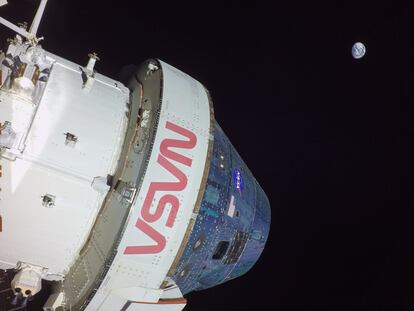‘Houston, we have a new record’: ‘Orion’ goes further than any other spacecraft designed to carry astronauts
The NASA capsule traveled nearly 270,000 miles from Earth on its trip to the Moon, a greater distance than the Apollo 13 program achieved in 1970

“Houston, we have a new record.” With this historically meaningful expression, NASA announced on social media that its Orion capsule has just broken the distance record for a human-rated spacecraft, that is, one capable of transporting astronauts. For now, the Orion’s crew is made up of three mannequins that have been instrumented to detect radiation and acceleration. There are also a couple of stuffed animals and hundreds of Snoopy pins on board. The previous distance record was held by Apollo 13 which, after sustaining serious damage from an explosion on board, had to follow a hastily calculated trajectory to return home. As NASA explains: “Orion was designed to take humans further into space than ever before and bring them back to Earth safely.”
On Tuesday of last week the capsule skimmed the Moon just over 100 kilometers (62 miles) above its surface, on Saturday it exceeded the distance record of 400,171 kilometers (248,655 miles) from Earth established by Apollo 13 on April 15, 1970 and then it moved away until it reached 434,523 kilometers (nearly 270,000 miles) from our home planet. And it did so by traveling along an orbit characterized as “distant” and “retrograde.” The meaning of “distant” is obvious, while “retrograde” alludes to the fact that Orion is revolving around the Moon in the opposite direction that the latter travels around the Earth.
That orbit is special in that it is so wide that it would encompass not only the Moon, but also the L1 Lagrange point of equilibrium, or the balance point between the pull of gravity from Earth and the Moon. Right now, Orion is navigating an invisible landscape of gravitational hills and valleys that fluctuates by the minute as our satellite progresses along its path.
Houston, we have a new record 🌎
— NASA's Johnson Space Center (@NASA_Johnson) November 26, 2022
On Saturday Nov. 26, at 8:40 a.m. ET, @NASA_Orion broke the record for the farthest distance traveled from Earth of a human-rated spacecraft. The record was previously held by Apollo 13 at 248,655 statute miles from Earth. Go Artemis! pic.twitter.com/B4hcXHJESC
Orion has managed to enter orbit with minimal fuel consumption, and has done so by taking advantage of that ghostly gravitational field. Its engine has spent barely two tons of fuel, four times less than what the Apollo used for the same maneuver. That is why the Orion’s engine is much less powerful than Apollo’s was 50 years ago, and its propellant reserves are scarcer.
The Orion capsule is now so far from the Moon that it has moved out of its sphere of influence and looks more like a satellite spinning on its own orbit around the Earth. The vagaries of celestial mechanics meant that the moment at which the maximum distance from the Moon was reached did not coincide with the furthest distance from the Earth. The first milestone was on Friday night; the second, three days later.
And while Orion continues on its way, another, much smaller satellite known as CAPSTONE has been exploring another very special trajectory for 10 days now: a near-rectilinear halo orbit (NRHO), a very elongated ellipse that passes over both poles of the Moon. It is the one that Artemis 3 will follow when it takes astronauts to set foot on the Moon again.
Sign up for our weekly newsletter to get more English-language news coverage from EL PAÍS USA Edition
Tu suscripción se está usando en otro dispositivo
¿Quieres añadir otro usuario a tu suscripción?
Si continúas leyendo en este dispositivo, no se podrá leer en el otro.
FlechaTu suscripción se está usando en otro dispositivo y solo puedes acceder a EL PAÍS desde un dispositivo a la vez.
Si quieres compartir tu cuenta, cambia tu suscripción a la modalidad Premium, así podrás añadir otro usuario. Cada uno accederá con su propia cuenta de email, lo que os permitirá personalizar vuestra experiencia en EL PAÍS.
¿Tienes una suscripción de empresa? Accede aquí para contratar más cuentas.
En el caso de no saber quién está usando tu cuenta, te recomendamos cambiar tu contraseña aquí.
Si decides continuar compartiendo tu cuenta, este mensaje se mostrará en tu dispositivo y en el de la otra persona que está usando tu cuenta de forma indefinida, afectando a tu experiencia de lectura. Puedes consultar aquí los términos y condiciones de la suscripción digital.
More information
Archived In
Últimas noticias
Most viewed
- Reinhard Genzel, Nobel laureate in physics: ‘One-minute videos will never give you the truth’
- Oona Chaplin: ‘I told James Cameron that I was living in a treehouse and starting a permaculture project with a friend’
- Pablo Escobar’s hippos: A serious environmental problem, 40 years on
- Why we lost the habit of sleeping in two segments and how that changed our sense of time
- Chevy Chase, the beloved comedian who was a monster off camera: ‘Not everyone hated him, just the people who’ve worked with him’











































